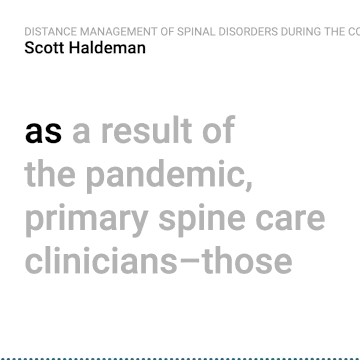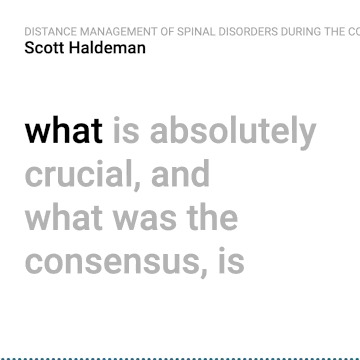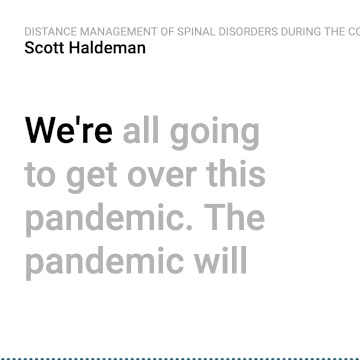The future of telehealth in spine care - SpineIQ Webinar
Scott Haldeman, founder, and president of World Spine Care, participated in a webinar hosted by SpineIQ, a community of high-performing conservative spine care clinicians who utilize non-pharmacological, non-invasive management of spine-related disorders. The webinar included presentations from Dr. Will Evans, Reid Holmes, as well as Dr. Christine Goertz, CEO of SpineIQ.
Dr. Haldeman's talk was titled Distance Management of Spinal Disorders during the COVID-19 Pandemic and Beyond. He discussed the challenges and changes in healthcare due to the coronavirus pandemic, the guides developed for clinicians and patients to manage back and neck pain from a distance, and the future of telehealth in spine care.
View the talk here or read more below.
Healthcare Has Changed
Over the past decade, the world has changed significantly. This past year has accelerated this change, particularly in the world of healthcare and especially spine care. The changes are so significant that it is unlikely that we are going to return to what we called used to call normal.
The COVID-19 pandemic caused people to be isolated from or have reduced access to their primary care practitioner, chiropractor, physiotherapist, or family doctor. However, this did not change the fact that people continued to have back pain, neck pain, disability, and disruption of their lives due to spinal disorders. The question of how these people should be managed during the pandemic became urgent.
COVID-19 Guides for Managing Back and Neck Pain
The Global Spine Care Initiative decided to address this question by constituting a panel of 28 spine care scientists, clinicians, and lay stakeholders from 10 countries on four continents. The result was the development of a Clinician Guide and a Patient Guide on Managing Back and Neck Pain in the Time of COVID-19.
The Global Spine Care Initiative papers published in a supplement issue of The European Spine Journal in 2018 were used as the basis for these Guides. These 15 scientific papers reviewed and summarized the literature on evidence-based spine care and presented a new classification system, care pathway, and model of care.
This panel presented five steps in the clinical management of spinal disorders and three addenda. It recommended using the Global Spine Care Initiative classification and sub-classification, and treatment recommendations. It also made recommendations on what to consider during telehealth consultation and suggested self-care recommendations.
The primary goal as a clinician being consulted by a patient with a spine-related problem is to document the symptoms and to triage for any red flags or serious disease that may require the patient to be seen for a face-to-face evaluation or referral for testing or specialist care.
There are 5 basic questions needed to achieve this goal:
What are the patient's problems or symptoms?
Does the pain radiate beyond the spine?
Are the symptoms stopping the patient from normal activities?
Has the patient experienced a recent fall or serious injury?
Is there a history consistent with red flag serious spine pathology?
The answers to these questions should give the clinician the information necessary to determine the GSCI Class of spinal disorder that best represents the patient’s symptoms: Minimal spine pain or concern (Class 0), Mild spine pain (Class I), Moderate or severe spine pain (Class II), neurological symptoms or problems (Class III), possible spine fracture or serious injury (Class IV) and possible serious spine pathology (Class V). Subclass determination by questioning the patient about the chronicity of the symptoms, whether the symptoms are progressive or stable, and whether there are any risk factors for spine pain and comorbidities.
With the determination of the patient’s Class of spine symptom, it is possible to triage the patient and make specific recommendations, and/or consider further investigation and referral. These treatment recommendations are based on the GSCI reviews of the literature and other nationally recognized evidence-based guidelines.
There were several specific points that the panel felt were important:
There are self-care options that patients can consider.
It is important to reassure patients that testing such as x-rays or MRI scans rarely helps in the decision on which treatment to consider unless there is a history of serious injury, neurological symptoms, or a red flag suggesting serious pathology.
Be available for regular follow-up contact with the patient (virtually).
The consensus was that the clinician must be available for regular follow-up, usually virtually. The patients need somebody to talk to when they have symptoms that they are concerned about. The clinician should also recognize that patient symptoms can change, they can get better or worse over time, and they could fall into different classes and subclasses requiring different treatment recommendations. At the same time, the clinician should ensure that patients are empowered to embrace self-management, and at the same time feel that they are cared for and have not been left alone. Online education or exercise classes can be offered through video consultations or advice over the phone. These consultations are now recognized by many insurance companies for reimbursement.
World Spine Care
World Spine Care is a nonprofit charity registered in the United States, Canada, and the United Kingdom to help people suffering from spinal pain in underserved communities around the world.
World Spine Care has clinical programs in Botswana, Dominican Republic, India, and Ghana which are run by volunteers. COVID-19 has impacted these clinics through travel restrictions but they are already opening again as the world slowly gets control of the pandemic. Over 50 volunteers have spent time in these clinics and have provided over 60,000 patient contacts. Anyone with an interest in volunteering at a World Spine Care clinic should visit www.worldspinecare.org.
The future of telehealth in spine care
The coronavirus pandemic will come to an end at some point, but there will be other pandemics. Telehealth is likely to become part of the average clinician’s practice, especially in underserved communities. In high-income, overserved communities, such as the United States and Europe, it is likely that patients will no longer want to wait in a doctor's office to get a basic examination and some information and advice. Chiropractors, physiotherapists, and other primary spine care clinicians are qualified and should be prepared to offer telehealth to people who have spine-related symptoms and help ensure that patients get the most appropriate advice and care.
Learn more about the Global Spine Care Initiative at globalspinecareinitiative.org.
Download the Patient and Clinician Guides on Managing Back and Neck Pain in the Time of COVID-19 from www.worldspinecare.org/covid-19-guide.






